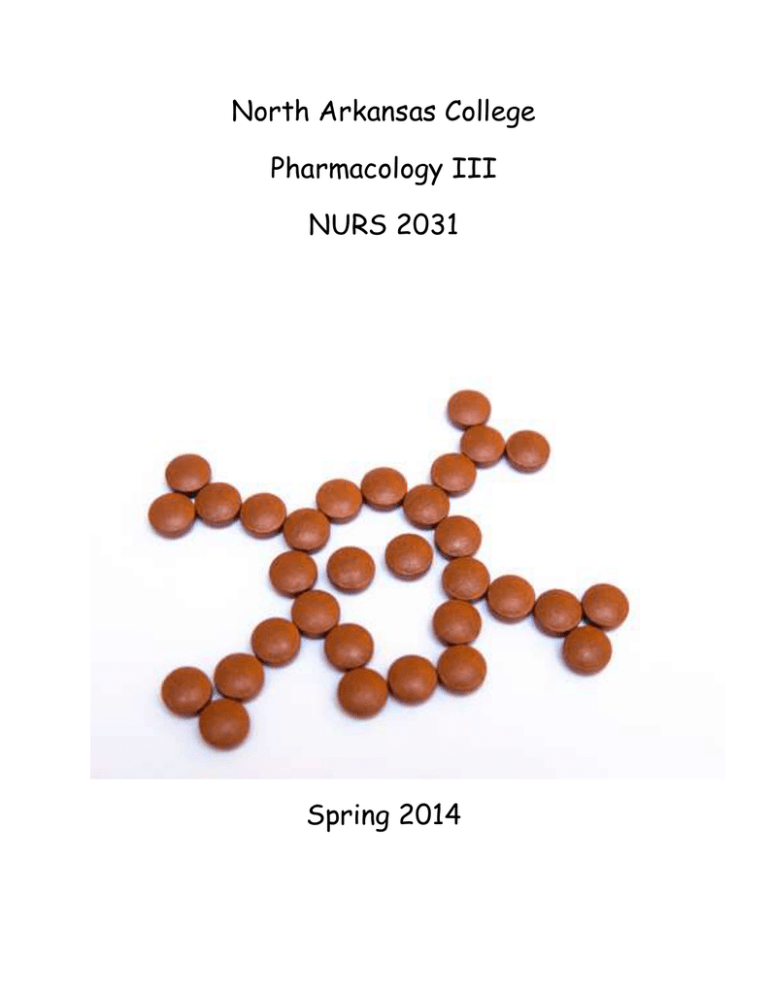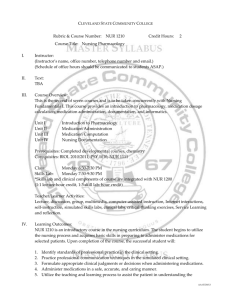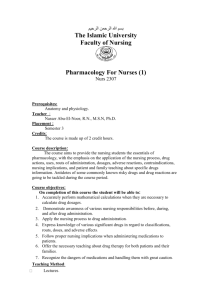North Arkansas College Pharmacology III NURS 2031 Spring 2014
advertisement

North Arkansas College Pharmacology III NURS 2031 Spring 2014 North Arkansas College Pharmacology III NURS 2031 Location/Class Meeting Times: Thursdays-1:30 pm – 2:30 pm Room 172 Course Description Pharmacology III is a 1-credit course designed to give nursing students a thorough and practical understanding of pharmacology for nursing practice. Emphasis at this level is placed on therapeutic action of medications, drug interactions, common dosages, administration and nursing responsibilities for monitoring/assessing and intervention during treatment of patients as well as patient and family teaching. Applicable evidence based studies will be highlighted throughout the course. Course Requirements Successful completion of Pharmacology I and Pharmacology II and grade of 79% or better for Pharmacology III will be necessary for continuation in the Registered Nursing program. Students are expected to take exams as scheduled. Make-up exams are given only with advanced notice and at the discretion of the instructor (will not be the same exam given during scheduled class) and will be taken within one week of the original test date. Students are allowed only one make-up exam per course. Textbooks Required Kee, J.L., Hayes, E.R.,& McCuistion, L. (2012). Pharmacology: A nursing process approach, (7th ed). Philadelphia: Saunders. Smeltzer, S. & Bare, B. (2010). Brunner & Suddarth’s Textbook of Medical-Surgical Nursing (12th ed.). Philadelphia: Lippincott. Instructors Amy Gipson, MSN, RN Office number: A100 A Office phone: 870-391-3169 Email: agipson@northark.edu Available to students at the following time: Monday Clinical Tuesday Clinical Office Hours: Wednesday: 9 am - 12 pm; 1 pm- 3 pm Thursday: 8:30 am- 3 pm (If not in class) Friday: By appointment Grading: Grading standards and examination policies for this course are consistent with those of North Arkansas College Registered Nursing Program Handbook. Please refer to this publication. End of Course evaluation is determined as follows: Module Exams 70% Final (Comprehensive) 20% ATI 10% Cumulative average of 79% is required for passage of course Grading Scale: 91-100 A 84-90 B 79-83 C 70-78 D <70 F General Policies: The Medical Surgical Nursing III course adheres to all policies in the Registered Nursing Program Handbook and the Northark Student Handbook. You are responsible for knowing the information in the Registered Nursing Program Handbook for this course. Absenteeism: Refer to your Registered Nursing Program Handbook. Make-Up Exams: 1. All exams should be taken at the scheduled time. 2. The student MUST notify the instructor prior to the exam if the student is unable to take the exam at the scheduled time. A missed examination is considered a class absence. 3. Arrangements must be made by the student as soon as possible. 4. Student may make-up ONE test only per semester at the instructor’s discretion. 5. Failure to comply with the stated requirements omits the privilege of taking a make-up test and a zero will be given for the test not taken. 6. An alternative exam may be administered ADA statement: North Arkansas College complies with Section 504 of the Rehabilitation Act of 1973 and the Americans with Disabilities Act of 1990. Students with disabilities who need special accommodations should make their requests in the following way: (1) talk to the instructor after class or during office hours about their disability or special need related to classroom work; and/or (2) contact Special Services in Room M188 and ask to speak to Kim Brecklein. Course Objectives: At the conclusion of Pharmacology III the student will be able to: 1. Incorporate evidenced based nursing into clinical decisions combining current research, clinical expertise and patient preferences (Spirit of Inquiry) 2. Plan nursing interventions that will result in appropriate and safe administration of medications (Nursing Judgment) 3. Formulate appropriate, culturally specific teaching strategies to improve patient compliance and understanding of a medication regimen (Human Flourishing, Professional Identity) 4. Explain pharmacological characteristics of specific classifications of drugs; their mechanism of action, uses, side effects, adverse reactions and nursing considerations as to age, race and existing medical problems (Professional Identity) Pharmacology III Course Modules Module I Chapter 40 Drugs for Upper Respiratory Disorders Chapter 41 Drugs for Lower Respiratory Disorders Chapter 32 Antituberculars Module II Chapter 42 Cardiac Glycosides, Antianginals, and Antidysrthythmics Chapter 44 Antihypertensives Chapter 45 Anticoagulants, Antiplatelets and Thrombolytics Chapter 46 Antilipidemics and Peripheral Vasodilators Module III Chapter 18 Adrenergics and Adrenergic Blockers Chapter 19 Cholinergics and Anticholinergics Module IV Chapter 22 Anticonvulsants Chapter 23 Parkinsonism and Alzheimer’s Disease Medications Chapter 24 Drugs for Neuromuscular Disorders: Myasthenia Gravis, Multiple Sclerosis, and Muscle Spasms Monday January 13 Tuesday January 14 Wednesday January 15 January 20 January 21 January 22 Thursday January 16 Module I Chapter 40 January 23 MLK Holiday No classes January 27 Clinical February 3 Clinical February 10 Clinical February 17 Clinical February 24 Clinical March 3 January 24 Module I Chapter 41 January 28 January 29 January 30 February 4 January 31 Module I Chapter 32 Clinical February 5 February 6 Module I Test February 7 February 12 February 13 Module II Chapter 42 February 14 February 19 February 20 Module II Chapter 44 February 21 February 26 February 27 Module II Chapters 45 & 46 February 28 March 5 March 6 Module II Test March 7 Clinical February 11 Clinical February 18 Clinical February 25 Clinical March 4 Clinical Friday January 17 Clinical March 10 Clinical (Optional ACLS) March 11 Clinical (Optional ACLS) March 12 March 13 Module III Chapters 18 & 19 March 14 March 17 March 18 March 19 March 20 Module III Chapter 59 March 21 March 26 March 27 March 28 Clinical March 24 Clinical March 25 Spring Break NURS 2031 Spring 2014 Calendar March 31 April 1 April 2 Preceptor Clinical Starts (60 hours) April 7 April 8 April 9 April 10 Module IV Chapter 22 and 23 April 11 April 15 April 16 April 17 Module IV Chapter 24 April 18 April 22 April 23 April 24 April 25 Precep Clinical April 21 Finish Precep Clinical April 28 May 5 April 4 Module III Test Precep Clinical April 14 April 3 Module IV Test April 29 May 6 Pharmacology III Final Exam April 30 May 1 May 7 ATI Comprehensive Pharmacology Test May 8 May 2 May 9 PINNING TONIGHT Graduation: Saturday, May 10 at 10 a.m. Module I: Drugs for Respiratory Disorders and Antitubercular Agents Course Outcomes: 1,2,3,4 OUTCOMES 1. Compare antihistamine, decongestant, antitussive, and expectorant drug groups. 2. Differentiate the drug groups used to treat COPD and asthma and the desired side effects of each. 3. Contrast the therapeutic effects of leukotriene antagonists, glucocorticoids, cromolyn, antihistamines, and mucolytics for COPD and asthma. 4. Develop a teaching plan for patients taking medications used for COPD, including asthma, and restrictive lung disease. 5. Explain the use of antitubercular drugs in the treatment of tubuerculosis. 6. Discuss strategies to improve medication compliance in patients taking antitubercular drugs. CONTENT 1. 2. 3. 4. 5. Action Therapeutic Uses Contraindications Side effects and adverse reactions Nursing Implications a. Pre assessment b. Teaching c. Post medication evaluation d. Food and drug interactions 6. Safety Implications a. b. c. d. e. Antihistamines Decongestants Antitussives Expectorants Alpha and Beta Adrenergic agonists f. Anticholinergics g. Methylxanthine derivatives h. Leukotriene receptor antagonists i. Anti-inflammatory drugs for COPD j. Antituberculars LEARNER ACTIVITIES Read Chapters 40, 41, 32 Read ATI Chapter 17-18 PowerPoint Role play a developed teaching plan for patients taking medications used to treat COPD Drug Highlights Diphenhydramine Dextromethorphan Hydrobromide Metaproterenol Montelukast Isoniazid Module II: Cardiovascular Agents Course Outcomes: 1,2,3,4 OUTCOMES 1. Differentiate the actions of cardiac glycosides, antianginal drugs, and antidysrhythmic drugs. 2. Compare the side effects and adverse reactions of nitrates, beta blockers, calcium channel blockers, quinidine, and procainamide. 3. Identify categories of antihypertensive drugs. 4. Give blood pressure guidelines for determining hypertension. 5. Apply essential teaching criteria for a patient taking cardiovascular agents. 6. Discuss strategies to improve medication compliance in patients taking antihypertensives. 7. Discuss the safety implications of administering anticoagulants, antiplatelets, and thrombolytics. 8. Discuss how to monitor for the side effects and adverse reactions of antihyperlipidemics and peripheral vasodilators. CONTENT 1. 2. 3. 4. 5. Action Therapeutic Uses Contraindications Side effects and adverse reactions Nursing Implications a. Pre assessment b. Teaching c. Post medication evaluation d. Food and drug interactions 6. Safety Implications a. b. c. d. e. f. g. h. i. j. Cardiac Glycosides Agents to treat heart failure Antianginals Antisysrhythmic drugs Antihypertensives Anticoagulants Antiplatelets Thrombolytics Antihyperlipidemics Peripheral vasodilators LEARNER ACTIVITIES Read Chapters 42, 44, 45, 46 Read ATI Chapters 20-25 PowerPoint Develop patient education handout with essential teaching points for patients taking cardiovascular medications used evidenced based practice strategies. Drug Highlights Digoxin Nitroglycerin Acebutolol HCL Amiodarone HCL Metoprolol Prazosin Heparin Coumadin Clopidogrel Bisulfate Alteplase Atorvastatin Isoxsuprine HCL Module III: Autonomic Nervous System Agents and Adult Emergency Drugs Course Outcomes: 1,2,3,4 OUTCOMES _________________________ 1. 2. 3. 4. 5. Describe the action on 1. major systems of the body of adrenergic agonists, adrenergic blockers, cholinergic agonists, and anticholinergics. Explain nursing interventions when administering adrenergic agonists, adrenergic blockers, cholinergic agonists, and anticholinergics. Describe safety implications with drug interactions with autonomic nervous system agents. Describe Indications for emergency drugs. Discuss nursing implications for the administration of emergency drugs. CONTENT ___________________________________ 1. 2. 3. 4. 5. Action Therapeutic Uses Contraindications Side effects and adverse reactions Nursing Implications a. Pre assessment b. Teaching c. Post medication evaluation d. Food and drug interactions 6. Safety Implications a. b. c. d. e. Adrenergic agonists Adrenergic blockers Cholinergic agonists Anticholinergics Emergency Drugs LEARNER ACTIVITIES ________________________ Read Chapters 18, 19, 59 PowerPoint Develop concept map study tool. Drug Highlights Albuterol Atenolol Bethanechol chloride Atropine Trihexyphenidyl HCL Tolterodine Tartrate Mannitol Naloxone Dopamine Module IV: Neurologic and Neuromuscular Agents Course Outcomes: 1,2,3,4 OUTCOMES ________________________ 1. Discuss how to safely 7. administer anticonvulsant medications. 2. Recognize the action and use of medications used to treat Parkinsonism. 3. Describe the side effects of antiparkinson drugs. 4. Explain the group of medications used to treat Alzheimer’s disease. 5. Discuss the drug group used to treat myasthenia gravis. 6. Explain the treatment strategies for the three phases of multiple sclerosis. 7. Summarize the teaching principles for patients taking medications for multiple sclerosis. 8. Differentiate between the muscle relaxants used for spasticity and those used for muscle spasms. 1. CONTENT __________________________________ 1. Action 2. Therapeutic Uses 3. Contraindications 4. Side effects and adverse reactions 5. Nursing Implications a. Pre assessment b. Teaching c. Post medication d. evaluation e. Food and drug interactions 6. Safety Implications a. Acetylcholinesterase Inhibitors b. Cholinesterase Inhibitors c. Skeletal Muscle Relaxants d. Centrally Acting Muscle Relaxants LEARNER ACTIVITIES _____________________ Read Chapters 22, 23, 24 PowerPoint Group activity case study Drug Highlights Pyridostigmine Bromide Carisoprodol Pharmacology Essentials Study Tool What is the action of the drug or class? What should happen and/or what could happen when a patient takes this medication? Is this a safe dose? When should you collaborate with a pharmacist? If they were having an allergic reaction, how would you know? What information lets you know the drug is effective? Evaluate patient response to medication (therapeutic effects, side effects, adverse reaction). Who should not take? Are there any food, drug or herbal interactions that stand out? What assessment information is required before administration? (labs, vital signs, allergies, contraindications) What safety principles must be followed to safely administer? What teaching do you provide to the patient when giving the medication? What teaching is necessary prior to discharge? What stands out about this medication (unique, such as ototoxicity, compromises renal function, do not stop abruptly, sit up after taking)?




